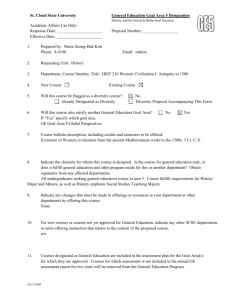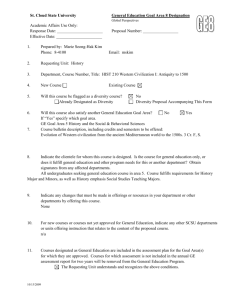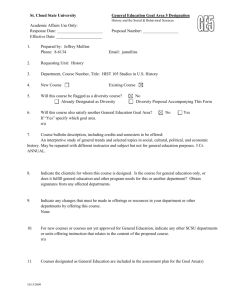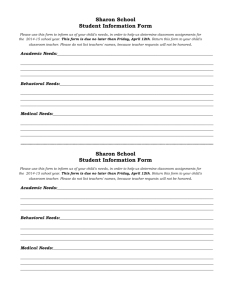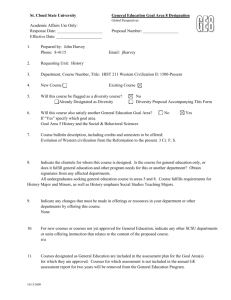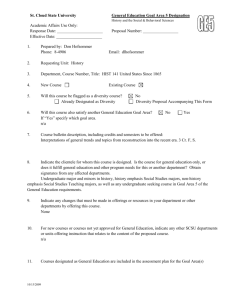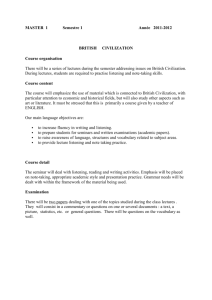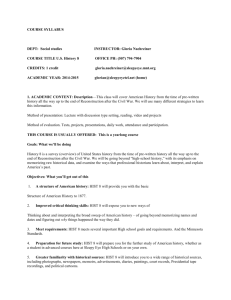GE-10-19. HIST 211 Western Civilization II: 1500
advertisement
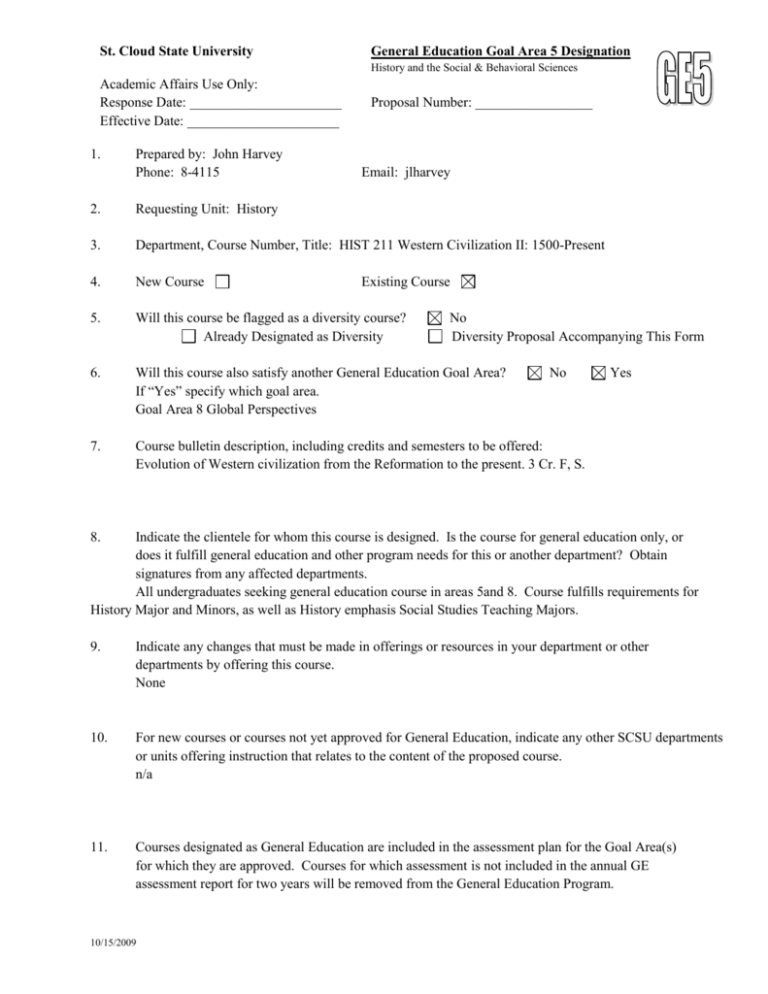
St. Cloud State University General Education Goal Area 5 Designation History and the Social & Behavioral Sciences Academic Affairs Use Only: Response Date: ______________________ Effective Date: ______________________ 1. Prepared by: John Harvey Phone: 8-4115 Proposal Number: _________________ Email: jlharvey 2. Requesting Unit: History 3. Department, Course Number, Title: HIST 211 Western Civilization II: 1500-Present 4. New Course 5. Will this course be flagged as a diversity course? Already Designated as Diversity 6. Will this course also satisfy another General Education Goal Area? If “Yes” specify which goal area. Goal Area 8 Global Perspectives 7. Course bulletin description, including credits and semesters to be offered: Evolution of Western civilization from the Reformation to the present. 3 Cr. F, S. Existing Course No Diversity Proposal Accompanying This Form No Yes 8. Indicate the clientele for whom this course is designed. Is the course for general education only, or does it fulfill general education and other program needs for this or another department? Obtain signatures from any affected departments. All undergraduates seeking general education course in areas 5and 8. Course fulfills requirements for History Major and Minors, as well as History emphasis Social Studies Teaching Majors. 9. Indicate any changes that must be made in offerings or resources in your department or other departments by offering this course. None 10. For new courses or courses not yet approved for General Education, indicate any other SCSU departments or units offering instruction that relates to the content of the proposed course. n/a 11. Courses designated as General Education are included in the assessment plan for the Goal Area(s) for which they are approved. Courses for which assessment is not included in the annual GE assessment report for two years will be removed from the General Education Program. 10/15/2009 The Requesting Unit understands and recognizes the above conditions. 12. Provide a concise explanation of how the following goal is a “significant focus” of the proposed course. Goal Area 5: History and the Social & Behavioral Sciences Develop understanding of human societies and behaviors, and of the concepts, theories, and methods of history and the social sciences. Through the examination of “Western Civilization” students will acquire a familiarity with major events and figures as studied via different human societies and behaviors. The student will also develop skills in critical reading of both primary and secondary sources, in research, in the comprehension of textual and lecture material, in class discussion, and in the composition of essays. 13. In order for a course to be designated as fulfilling Goal Area 5, it must address at least 4 of the 5 student learning outcomes (SLOs) below. Check the SLOs below that are focused on in the proposed general education course. 1. Describe or use the methods and data by which historians, social scientists, or behavioral scientists investigate human conditions. 2. Analyze human behavior, cultures, and social institutions and processes from the perspectives of history or the social and behavioral sciences. 3. Develop explanations for and explore solutions to historical or contemporary social problems. 4. Reflect upon themselves in relation to family, communities, society, culture, and/or their histories. 5. Apply and critique alternative explanatory systems or theories about human societies and behaviors. 14. Discuss how each Student Learning Outcome checked above is achieved in this course. (Note: Although descriptions of typical assignments or types of assignments may be part of this discussion, it is not appropriate to submit copies of actual assignments.) 13.1 Students in HIST 211 are offered the opportunity to write analytical responses, which are based on key historical concept that remain in debate. Students are expected to work with primary sources, such as the first-hand accounts of contemporaries, as the material that they must use to address the question. Although methods of historical criticism can only be touched on in this introductory course, the longer exams also request that students support their written answers with evidence from the primary sources which are available to the students (in the form of handouts, readers, or e-reserve.) 13.2: Students are taught to understand and to appreciate the diversity of ethnicities, governments, religions, and cultures that have developed through the European continent since the sixteenth century. They are asked to read a master textbook, but also supplementary texts which address specific issues of social development in greater detail than in the general lectures. Students are asked to write shorter assignments on a range of topics that deal with European societies, and their contact with non-European peoples. The mid-term and final exams ask students to treat broader historical themes that are covered in the lectures and short response assignments. 13.3 Students in HSIT 211 are asked to offer perspectives on important historical topics dealing with European history based on an awareness of present-minded conditions. Their grades are not based on a “correct” view of 10/15/2009 the present. But student responses to topical questions are graded in part by the degree to which they base their arguments both on wider analytical comparison and context, as well as concrete historical evidence. 13.4 Students are introduced to topics of European history by contextualizing historical topics with more familiar contemporary subject-matter. This occurs in the lectures and with the response essays. They are asked to volunteer their own experiences, where appropriate, to extend this sense of context, comparison, and familiarity. 13.5 Students in HIST 211 are asked repeatedly to critique a given historical explanation, mostly in the short responses, and then further in class discussion Students are asked to offer an independent evaluation of historical documents or interpretations, based on what they would have learned in earlier lectures, the textbook, and/or other supplementary readings. Students are evaluated on the degree of preparation, analytical depth, and the breadth/command of evidence that they demonstrate in written and verbal communication. 15. 1. 2. 3. 4. 5. 6. 7. 8. 9. 10. 11. List or attach the Course Outline (adequately described and including percentage of time to be allocated to each topic). Curriculum Committees may request additional information. Topics larger than 20% need to be broken down further. Indicate in your course outline where the Student Learning Outcomes checked above are being met. The Student Learning Outcomes are met throughout the curriculum described in the course outline below: Introduction 5% Reformation 10% Rise of Modern States 10% Scientific revolution & Enlightenment 10% French Revolution 10% Industrial Revolution 10% Imperialism and 19th-century culture 10% World War I 10% World War II 10% Cold War 10% Conclusions 5% 10/15/2009
